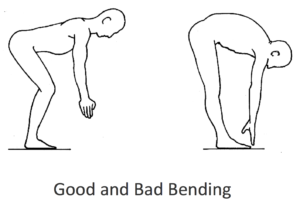This article was first published in "Going Mental" by Daniel McGowan
Fitness and Misuse

Note: Read in conjunction with the article, The Danger to the Lumbar Spine while Performing Sit-Ups
Most exercises aimed at improving one’s fitness are to no avail, veritable exercises in futility! They can cause more harm than good. It is the mistaken belief of many people that if you push and pull the body around with great vigour – especially using weights – until you are sweating profusely and breathing heavily, then you are making yourself fit.
Too often the suitability of these exercises for the co-ordinated use of the mechanism is not appreciated. Many of them are incompatible with co-ordinated use. They are too numerous to deal with them in this book, but a few examples will be given.
The man on the right in the picture above is performing a gross misuse of the organism. He is attempting to bend his knees backwards and this they cannot do. He is cancelling out his hip joints by bending as if he had a hinge at the bottom of his spine where the 5th lumbar vertebra meets the sacrum. He is in great danger of causing himself a slipped disc, because his lumbar spine is being excessively lengthened(see The Danger to the Lumbar Spine while Performing Sit-Ups for illustration). To make matters worse, his abdominal muscles are being shortened and his vital organs in the torso are being squashed.
Incidentally, I would like to meet the man who decided to be able to bend down like this and touch your toes was proof that you were in good shape. The spine is a semi-rigid structure and should be flexible enough to bend, but it is not built primarily for bending; the hip joints are. Note also that his neck muscles are severely shortened. When he reaches the furthest point to which he can bend, his lumbar region is prevented from splitting apart only by the inherent passive strength of the ligaments, discs and vertebrae, because his back muscles are over-relaxed. In short, this extreme situation is inefficient, unco-ordinated, passive and dangerous.
If he repeats the act of bending vigorously up and down often enough, he will be subjecting his lumbar spine to tremendous bending forces that can produce dire consequences. I read of an athlete of Olympic standard who was told by his coach that he was not supple enough and to remedy this he should practice a lot of toe-touches. This the athlete did with great enthusiasm and gave himself a slipped disc that ended his career. Even a steel rod will eventually break if you bend it backwards and forwards often enough.
In contrast, the man on the left picture is displaying good co-ordinated use of the mechanism. His form is hinged at the ankles, knees and hip joints. The integrity of his head-neck-back relationship is not being disturbed; that means his back is at its optimal length, his head is going forward and up along the line of his back and his vital organs have the freedom they need to function well. You can see, if you tilt the page so that his torso comes to the vertical, that his head-neck-torso relationship is the same as it would be if he were standing up. If he picks something up in this dynamic situation, the muscles of his lower back will react efficiently, not only to take the load, but also to prevent the lumbar spine from buckling, thus reducing greatly the danger of a slipped disc.
In short this situation is efficient, co-ordinated, dynamic and safer. I do not say completely safe, because even in this situation, to pick up a load of only 10 kg (plus the self-weight of the torso, arms and head don’t forget) means the resultant force at the lumbar sacral joint is approximately 250kg (40 stones). We are not built for lifting heavy loads.
This article was first published in Going Mental by Daniel McGowan. You can download the PDF of this book for free here: FREE DOWNLOAD